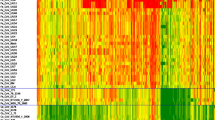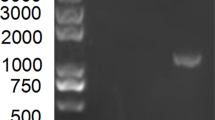Abstract
Feline coronavirus (FCoV) is the causative agent of feline infectious peritonitis and diarrhoea in kittens worldwide. In this study, a total of 73 feline diarrhoeal faecal samples were collected from animal hospitals and pet markets in ShanDong province from 2017 to 2019. FCoV was detected in 58.23% (46/73) of the samples, using the RT-PCR method. The results showed that the detection rate of FCoV in healthy cats and sick cats was 41.7% (10/24) and 81.6% (40/49), respectively. Full gene amplification and sequencing of the N, M, and S2 genes of FCoV isolates were performed. An amino acid mutation (M1058L) in the S2 gene was found that can be used as a marker for distinguishing feline enteric coronavirus (FECV) from feline infectious peritonitis virus (FIPV). This study provides new epidemiological information about FCoV that will aid in the prevention of FCoV in China.






Similar content being viewed by others
Data availability
All data generated or analyzed during this study are included in this published article and its supplementary PDF file.
References
Addie DD, Jarrett O (1992) A study of naturally occurring feline coronavirus infections in kittens. Vet Rec 130(7):133–137. https://doi.org/10.1136/vr.130.7.133
Boyle JF, Pedersen NC, Evermann JF, McKeirnan AJ, Ott RL, Black JW (1984) Plaque assay, polypeptide composition and immunochemistry of feline infectious peritonitis virus and feline enteric coronavirus isolates. Adv Exp Med Biol 173:133–147. https://doi.org/10.1007/978-1-4615-9373-7_12
Motokawa K, Hohdatsu T, Hashimoto H, Koyama H (1996) Comparison of the amino acid sequence and phylogenetic analysis of the peplomer, integral membrane and nucleocapsid proteins of feline, canine and porcine coronaviruses. Microbiol Immunol 40(6):425–433. https://doi.org/10.1111/j.1348-0421.1996.tb01089.x
Shiba N, Maeda K, Kato H, Mochizuki M, Iwata H (2007) Differentiation of feline coronavirus type I and II infections by virus neutralization test. Vet Microbiol 124(3–4):348–352. https://doi.org/10.1016/j.vetmic.2007.04.031
Vennema H, Poland A, Foley J, Pedersen NC (1998) Feline infectious peritonitis viruses arise by mutation from endemic feline enteric coronaviruses. Virology 243(1):150–157. https://doi.org/10.1006/viro.1998.9045
Pedersen NC (2009) A review of feline infectious peritonitis virus infection: 1963–2008. J Feline Med Surg 11(4):225–258. https://doi.org/10.1016/j.jfms.2008.09.008
Rottier PJ, Nakamura K, Schellen P, Volders H, Haijema BJ (2005) Acquisition of macrophage tropism during the pathogenesis of feline infectious peritonitis is determined by mutations in the feline coronavirus spike protein. J Virol 79(22):14122–14130. https://doi.org/10.1128/jvi.79.22.14122-14130.2005
Tekes G, Thiel HJ (2016) Feline coronaviruses: pathogenesis of feline infectious peritonitis. Adv Virus Res 96:193–218. https://doi.org/10.1016/bs.aivir.2016.08.002
Hohdatsu T, Yamato H, Ohkawa T, Kaneko M, Motokawa K, Kusuhara H, Kaneshima T, Arai S, Koyama H (2003) Vaccine efficacy of a cell lysate with recombinant baculovirus-expressed feline infectious peritonitis (FIP) virus nucleocapsid protein against progression of FIP. Vet Microbiol 97(1–2):31–44. https://doi.org/10.1016/j.vetmic.2003.09.016
Wasmoen TL, Kadakia NP, Unfer RC, Fickbohm BL, Cook CP, Chu HJ, Acree WM (1995) Protection of cats from infectious peritonitis by vaccination with a recombinant raccoon poxvirus expressing the nucleocapsid gene of feline infectious peritonitis virus. Adv Exp Med Biol 380:221–228. https://doi.org/10.1007/978-1-4615-1899-0_36
Armstrong J, Niemann H, Smeekens S, Rottier P, Warren G (1984) Sequence and topology of a model intracellular membrane protein, E1 glycoprotein, from a coronavirus. Nature 308(5961):751–752. https://doi.org/10.1038/308751a0
Poland AM, Vennema H, Foley JE, Pedersen NC (1996) Two related strains of feline infectious peritonitis virus isolated from immunocompromised cats infected with a feline enteric coronavirus. J Clin Microbiol 34(12):3180–3184. https://doi.org/10.1128/jcm.34.12.3180-3184.1996FromNLM
Battilani M, Balboni A, Bassani M, Scagliarini A, Paltrinieri S, Prosperi S (2010) Sequence analysis of the nucleocapsid gene of feline coronaviruses circulating in Italy. New Microbiol 33(4):387–392
Bank-Wolf BR, Stallkamp I, Wiese S, Moritz A, Tekes G, Thiel HJ (2014) Mutations of 3c and spike protein genes correlate with the occurrence of feline infectious peritonitis. Vet Microbiol 173(3–4):177–188. https://doi.org/10.1016/j.vetmic.2014.07.020
Kennedy M, Citino S, McNabb AH, Moffatt AS, Gertz K, Kania S (2002) Detection of feline coronavirus in captive Felidae in the USA. J Vet Diagn Invest 14(6):520–522. https://doi.org/10.1177/104063870201400615
Benetka V, Kolodziejek J, Walk K, Rennhofer M, Möstl K (2006) M gene analysis of atypical strains of feline and canine coronavirus circulating in an Austrian animal shelter. Vet Rec 159(6):170–174. https://doi.org/10.1136/vr.159.6.170
Taharaguchi S, Soma T, Hara M (2012) Prevalence of feline coronavirus antibodies in Japanese domestic cats during the past decade. J Vet Med Sci 74(10):1355–1358. https://doi.org/10.1292/jvms.11-0577
Li C, Liu Q, Kong F, Guo D, Zhai J, Su M, Sun D (2019) Circulation and genetic diversity of Feline coronavirus type I and II from clinically healthy and FIP-suspected cats in China. Transbound Emerg Dis 66(2):763–775. https://doi.org/10.1111/tbed.13081
Bell ET, Toribio JA, White JD, Malik R, Norris JM (2006) Seroprevalence study of feline coronavirus in owned and feral cats in Sydney Australia. Aust Vet J 84(3):74–81. https://doi.org/10.1111/j.1751-0813.2006.tb12231.x
Sharif S, Arshad SS, Hair-Bejo M, Omar AR, Zeenathul NA, Hafidz MA (2009) Prevalence of feline coronavirus in two cat populations in Malaysia. J Feline Med Surg 11(12):1031–1034. https://doi.org/10.1016/j.jfms.2009.08.005
Chang HW, Egberink HF, Halpin R, Spiro DJ, Rottier PJ (2012) Spike protein fusion peptide and feline coronavirus virulence. Emerg Infect Dis 18(7):1089–1095. https://doi.org/10.3201/eid1807.120143
Licitra BN, Millet JK, Regan AD, Hamilton BS, Rinaldi VD, Duhamel GE, Whittaker GR (2013) Mutation in spike protein cleavage site and pathogenesis of feline coronavirus. Emerg Infect Dis 19(7):1066–1073. https://doi.org/10.3201/eid1907.121094
Decaro N, Mari V, Lanave G, Lorusso E, Lucente MS, Desario C, Colaianni ML, Elia G, Ferringo F, Alfano F et al (2021) Mutation analysis of the spike protein in Italian feline infectious peritonitis virus and feline enteric coronavirus sequences. Res Vet Sci 135:15–19. https://doi.org/10.1016/j.rvsc.2020.12.023
Funding
Fund information is Cooperation project with Qingdao Biotephy Co., Ltd(20220668).
Author information
Authors and Affiliations
Corresponding authors
Ethics declarations
Conflict of interest
The authors have not disclosed any competing interests.
Additional information
Handling Editor: Sheela Ramamoorthy.
Publisher's Note
Springer Nature remains neutral with regard to jurisdictional claims in published maps and institutional affiliations.
Rights and permissions
Springer Nature or its licensor (e.g. a society or other partner) holds exclusive rights to this article under a publishing agreement with the author(s) or other rightsholder(s); author self-archiving of the accepted manuscript version of this article is solely governed by the terms of such publishing agreement and applicable law.
About this article
Cite this article
Song, XL., Li, WF., Shan, H. et al. Prevalence and genetic variation of the M, N, and S2 genes of feline coronavirus in Shandong Province, China. Arch Virol 168, 227 (2023). https://doi.org/10.1007/s00705-023-05816-4
Received:
Accepted:
Published:
DOI: https://doi.org/10.1007/s00705-023-05816-4




